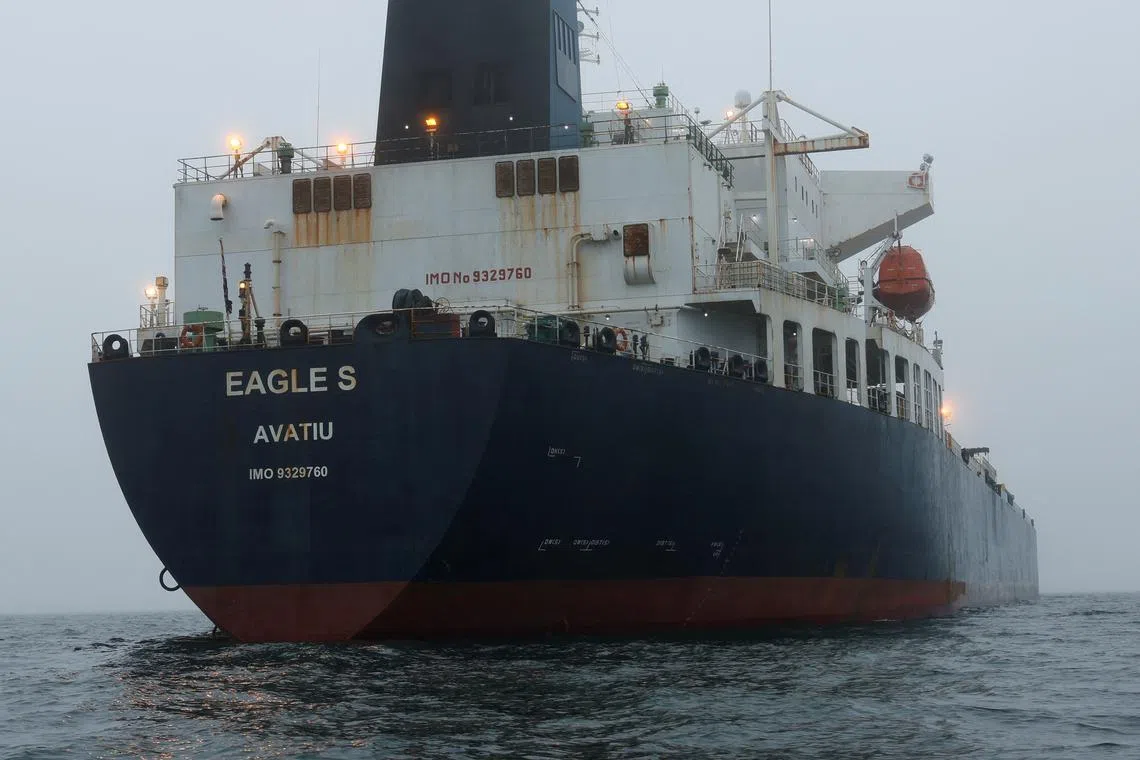Nato to boost Baltic Sea presence after undersea power, internet cables broken
Sign up now: Get ST's newsletters delivered to your inbox

The oil tanker Eagle S seen moored off the coast of Finland on Dec 27.
PHOTO: REUTERS
Follow topic:
HELSINKI - Nato said on Dec 27 it would boost its presence in the Baltic Sea after the suspected sabotage this week of an undersea power cable and four internet cables, while alliance member Estonia launched a naval operation to guard a parallel electricity link.
Finland on Dec 26 seized a ship carrying Russian oil on suspicion of causing an outage of the Estlink 2 undersea power cable
Baltic nations are on alert after a string of outages
“We have agreed with Estonia, and we have also communicated to Nato Secretary-General Mark Rutte, that our wish is to have a stronger Nato presence,” Finnish President Alexander Stubb told a news conference.
Mr Rutte posted on social media platform X that “Nato will enhance its military presence in the Baltic Sea”, without elaborating. A Nato official declined to provide further detail.
Sweden’s coast guard said it had increased surveillance of ship traffic, deploying aircraft and vessels and coordinating with other nations.
The Kremlin said Finland’s seizure of the ship carrying Russian oil was of little concern to it. In the past, Russia has denied involvement in any of the Baltic infrastructure incidents.
Estonia said its navy was guarding the still-operational Estlink 1 power cable.
“If there is a threat to the critical undersea infrastructure in our region, there will also be a response,” Foreign Minister Margus Tsahkna said on X.
He said on Dec 26 that such incidents had become so frequent it was hard to believe they were all caused by accidents or poor seamanship.
Estonia’s Justice Minister said they highlighted the need to update centuries-old maritime law to explicitly outlaw such damage.
The 658 megawatt (MW) Estlink 2 outage began at midday on Dec 25, leaving only the 358MW Estlink 1 linking Finland and Estonia, grid operators said. They said Estlink 2, which was feeding power to Estonia at the time, might not be back in service before August.
Russian ‘shadow fleet’
Finnish investigators believe the seized ship, registered in the Cook Islands and named as the Eagle S, may have caused the damage by dragging its anchor along the seabed.
Video and photos published on Dec 27 by the Finnish daily Ilta-Sanomat showed the Eagle S with a single anchor chain stretching into the sea from its starboard side, while the hole where the port side anchor chain would normally be was empty.
Finland’s customs service believes the ship is part of a “shadow fleet” of ageing tankers
Finnish police said they were investigating the Eagle S on suspicion of “aggravated criminal mischief”, and that crew members had been questioned.
United Arab Emirates-based Caravella, which according to MarineTraffic data owns the Eagle S, did not respond to requests for comment.
India’s Peninsular Maritime, which according to MarineTraffic acts as technical manager for the ship, was not immediately available for comment.
The power cable outage will not prevent the planned decoupling of Estonia, Latvia and Lithuania from a Soviet-era power grid shared with Russia and Belarus, Estonia’s grid operator Elering said.
But the breach means power prices in the Baltic countries are likely to be higher than expected in 2025, while those in Finland and the average of the Nordic region will probably be lower, LSEG power market analyst Ole Tom Djupskaas said.
Swedish police are still investigating November’s breach of two telecoms cables, and have named a Chinese ship travelling from Russia as a possible culprit.
Separately, Finnish and Estonian police are continuing a probe into 2023’s damage to the Balticconnector gas pipeline and several telecoms cables, in which another Chinese vessel arriving from Russia was named. REUTERS

